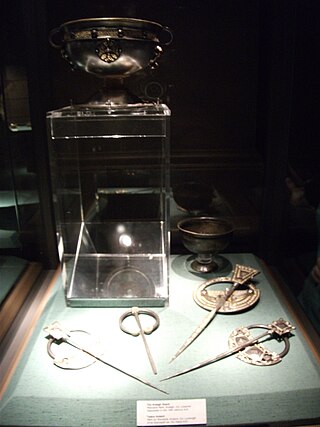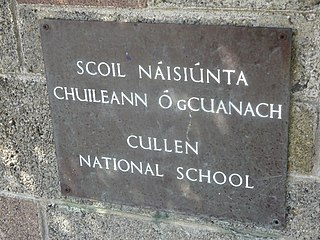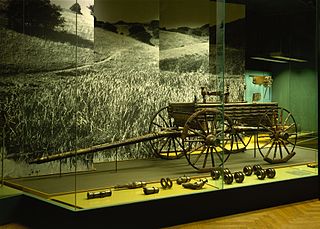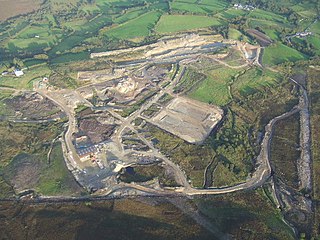
Bealtaine is the Gaelic May Day festival. It is traditionally held on 1 May, or about midway between the spring equinox and summer solstice in the northern hemisphere. The festival name is synonymous with the month marking the start of summer in Gaelic Ireland. Historically, it was widely observed throughout Ireland, Scotland, and the Isle of Man. In Irish the name for the festival day is Lá Bealtaine while the month of May is Mí na Bealtaine, in Scottish Gaelic Latha Bealltainn, and in Manx Gaelic Laa Boaltinn/Boaldyn. Beltane is one of the four main Gaelic seasonal festivals—along with Samhain, Imbolc, and Lughnasadh—and is similar to the Welsh Calan Mai.

Lugh or Lug is a figure in Irish mythology. A member of the Tuatha Dé Danann, a group of supernatural beings, Lugh is portrayed as a warrior, a king, a master craftsman and a savior. He is associated with skill and mastery in multiple disciplines, including the arts. Lugh also has associations with oaths, truth and the law, and therefore with rightful kingship. Lugh is linked with the harvest festival of Lughnasadh, which bears his name. His most common epithets are Lámfada and Samildánach.
Conn Cétchathach, or Conn of the Hundred Battles, son of Fedlimid Rechtmar, was a semi-legendary High King of Ireland who is the ancestor of the Connachta, and through his descendant Niall Noígiallach, the Uí Néill dynasties, which dominated Ireland in the early Middle Ages.

Manannán or Manann, also known as Manannán mac Lir, is a warrior and king of the Otherworld in Irish and Manx mythology who is associated with the sea and often interpreted as a sea god, usually as a member of the Tuatha Dé Danann.

The Ardagh Hoard, best known for the Ardagh Chalice, is a hoard of metalwork from the 8th and 9th centuries. Found in 1868 by two young local boys, Jim Quin and Paddy Flanagan, it is now on display in the National Museum of Ireland in Dublin. It consists of the chalice, a much plainer stemmed cup in copper-alloy, and four brooches — three elaborate pseudo-penannular ones, and one a true pennanular brooch of the thistle type; this is the latest object in the hoard, and suggests it may have been deposited around 900 AD.

The Gaelic revival was the late-nineteenth-century national revival of interest in the Irish language and Irish Gaelic culture. Irish had diminished as a spoken tongue, remaining the main daily language only in isolated rural areas, with English having become the dominant language in the majority of Ireland.
The golden apple is an element that appears in various national and ethnic folk legends or fairy tales. Recurring themes depict a hero retrieving the golden apples hidden or stolen by a monstrous antagonist. Gold apples also appear on the Silver Branch of the Otherworld in Irish mythology.

The prehistory of Ireland has been pieced together from archaeological evidence, which has grown at an increasing rate over the last decades. It begins with the first evidence of permanent human residence in Ireland around 10,500 BC and finishes with the start of the historical record around 400 AD. Both the beginning and end dates of the period are later than for much of Europe and all of the Near East. The prehistoric period covers the Palaeolithic, Mesolithic, Neolithic, Bronze Age and Iron Age societies of Ireland. For much of Europe, the historical record begins when the Romans invaded; as Ireland was not invaded by the Romans its historical record starts later, with the coming of Christianity.

Cullen is a rural village in County Tipperary, Ireland. The centre of the village is located at a junction of two roads in south Tipperary. These roads lead to Monard, Lattin, the "Rocky Road" and Oola respectively.

Lattin is a village and civil parish in south County Tipperary in Ireland. It is within the historical barony of Clanwilliam, and is also one half of the 'Lattin and Cullen' parish in the Roman Catholic Archdiocese of Cashel and Emly. Lattin village is located on the R515 regional road between the towns of Emly and Tipperary.
Saint Bricín was an Irish abbot of Tuaim Dreccon in Breifne, a monastery that flourished in the 7th century.
Maelsuthan Ua Cerbhail, Maelsuthain O'Carroll, or Maelsuthain O'Cearbhail was a political and academic figure in medieval Ireland. He was lord of the Eóganacht Locha Léin, advisor to High King Brian Boru, and an important scholar often credited for beginning the Annals of Innisfallen. Maelsuthan's academic reputation was considerable, earning him accolades like "chief doctor of the Western world in his time" and "sage of Ireland."

The National Museum of Ireland – Archaeology is a branch of the National Museum of Ireland located on Kildare Street in Dublin, Ireland, that specialises in Irish and other antiquities dating from the Stone Age to the Late Middle Ages.
Failinis [FAW IHN-ish] or Ṡalinnis/Shalinnis is a dog in the Mythological Cycle of Irish literature, belonging to Lugh Lámhfhada of the Tuatha Dé Danann; it was one of the eric (reparation) items exacted from the sons of Tuireann.

The Dowris Hoard is the name of an important Bronze Age hoard of over 200 objects found in Dowris, County Offaly, Ireland. Items from the deposit are currently split between two institutions: the National Museum of Ireland in Dublin and the British Museum in London.

The Dejbjerg wagon is a composite of two ceremonial wagons found in a peat bog in Dejbjerg near Ringkøbing in western Jutland, Denmark. These votive deposits were dismantled and ritually placed in the bog around 100 BCE. As of 2022, the wagon is on display at the National Museum of Denmark.

In many areas of Scandinavia, a wide variety of items were deposited in lakes and bogs from the Mesolithic period through to the Middle Ages. Such items include earthenware, decorative metalwork, weapons, and human corpses, known as bog bodies. As Kaul noted, "we cannot get away from the fact that the depositions in the bogs were connected with the ritual/religious sphere."
In Gaelic Ireland, a bruiden was a building offering shelter, drink and food, often translated as "hostel", "banqueting hall" or "inn."

Irish gold is gold that occurs naturally in areas of Ireland. Ireland was the major area of gold working in the Bronze Age British Isles. Irish gold is especially well known from the Irish Bronze Age as jewellery, in the form of gold lunulae, torcs, gorgets and rings.













